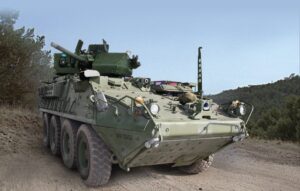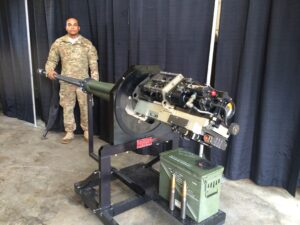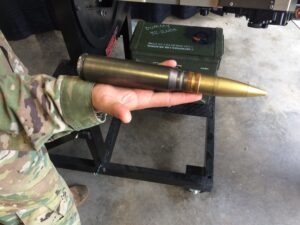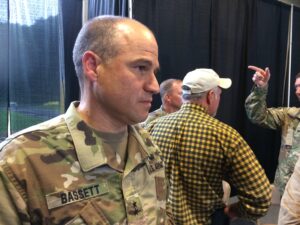ABERDEEN PROVING GROUND: Two years after the Europe-based 2nd Cavalry Regiment requested more firepower to deter the Russians, 30 millimeter shells and Javelin missiles thundered downrange here at the Army’s oldest proving ground. Even standing at a safe distance, 20 yards from the closest of the two Stryker vehicles, I could feel the muzzle blast from the cannon, making my clothes flap. I could see the fireball from the Javelin hitting its target maybe a mile away.
This week, the Army was rolling out its newest combat vehicles, upgunned models of the eight-wheel-drive Stryker, to impress the press and Congress – and, of course, the Russian military.

Prototype XM1296 Stryker Infantry Carrier Vehicle – Dragoon.
“You can throw a machinegun on a technical vehicle that had farther reach than our own .50 caliber did,” Lt. Col. Troy Meissel said, referring to the standard Russian-made 14.5 mm DShK Dushka. He’s deputy commander of the 2nd Cavalry, the Army’s frontline Stryker regiment, who flew in from Europe for this week’s events.
“The crews here were engaging targets at 3,200 meters (two miles),” Meissel told me. By contrast, a .50 cal machinegun has an effective range of about 2,000 meters. Stryker platoons do have Javelin missile launchers with a range of 2,500 meters (under 1.6 miles), Meissel said, but those are handheld weapons, not mounted on the vehicle. Someone has to jump out carrying a launcher and fire from whatever cover he can find. The new Javelin-equipped Strykers will let troops fire the missile while under armor, a safer and quicker operation.

The 30 mm autocannon mounted in the Stryker Dragoon (soldier for scale)
The biggest news, though not the biggest bang, this week: The Army will soon decide whether to buy Israeli-made Trophy Active Protection Systems for its M1 tanks, letting them shoot down incoming anti-tank missiles too powerful for their armor.
The Army isn’t building new designs, however, with the partial exception of its Armored Multi-Purpose Vehicle, essentially a turretless variant of the venerable M2 Bradley troop carrier. Without the money to develop all-new war machines to take on the Russians, as it last did in the 1980s, the service is rushing to field better versions of existing vehicles. Unfortunately, funding shortfalls will limit how fast frontline units can actually get them.

Close-up of a 30 mm shell from the Stryker Dragoon’s autocannon (soldier’s hand for scale)
- Yesterday and today, upgunned models of the 25-ton Stryker fired new 30 millimeter autocannons and Javelin anti-tank missiles. The Javelin launchers, which replace existing weapon mounts, will go to every Stryker unit, eventually. For now, the 30 mm gun “Dragoon” variant, which requires extensive modifications to accommodate a new turret, is only funded for 83 vehicles of the 2nd Cavalry Regiment. The program has requested funding for a second brigade.
- Today, the latest upgrade of the Abrams tank, the 73-ton M1A2 SEP V3, test-fires its 120 mm cannon with new sensors here at Aberdeen; reliability testing has already shown the V3 suffers fewer breakdowns than the current models. Work is also underway on an upgraded Bradley troop carrier, the M2A4; an upgraded Paladin howitzer, the M109A7; and a replacement for the geriatric M113, the Armored Multi-Purpose Vehicle (AMPV). All heavy armored brigade combat teams (ABCTs) will get these upgrades eventually, but under current funding it’ll take several years to convert just the first brigade to the new Abrams and Bradleys.
- This fall, after extensive field tests, the Army will decide whether to start buying Israeli-built Trophy Active Protection System for its M1s. The service is testing the Iron Curtain and Iron Fist systems alongside Trophy, and it’s testing APS on Strykers and (soon) on Bradleys, but these other possibilities are lagging the Trophy-M1 tank combination. The immediate decision: whether to buy enough Trophies to equip the M1s in one brigade.

Maj. Gen. David Bassett
Necessity is the mother of invention here, but that doesn’t make the necessity less dire. The downside of doing all these innovations at once is the Army can only afford to buy each one in dribbles and drabs. That’s economically inefficient, since you’re paying the overhead to keep production lines going for only a few vehicles.
How the Army’s making do — and where it’s struggling — we’ll discuss in Part II of this article, out tomorrow.
Источник
Комментариев нет:
Отправить комментарий